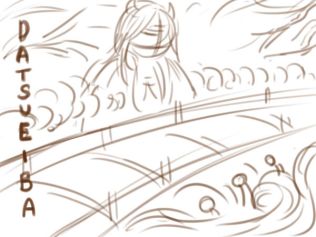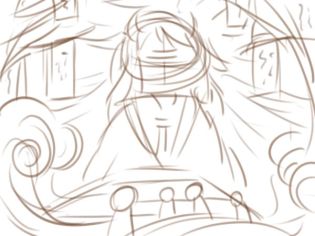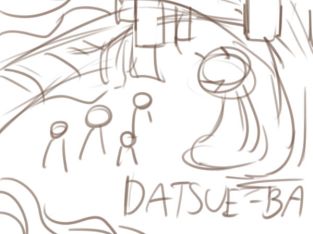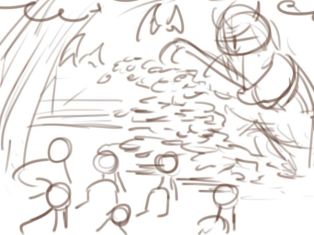
There are many stories and beliefs about the life after death which are told by different culture. No one knows which story is true, but every story has their own traditional origin. In Japanese Buddhist traditional belief, the journey of the spirit will begin after the death. The souls of the deceased people have to cross the river called Sanzu River. And at the river’s edge, they will meet the demons called “Datsue-ba”.
Datsue-ba has an appearance like an old woman. She has ugly withered face and sharp teeth. She usually wears a loose Japanese cloth which shows her skinny body. These appearances make her looks like a demon than a beast. For the pose of Datsua-ba, which we usually see from the pictures in the books or statues, she will sit down with one knee up. Datsue-ba will sit at the edge of the Sanzu River. It lies between the first and second Judges of Hell. There are other names of Sanzu River which are River of Three Roads or River of Three Crossings. In Japanese, the Sanzu River is known as Sanzu No Kawa. People know Datsue-ba as the one of the keepers of hell who lives in the Buddhist underworld. Her main duty is to strip the clothes from the bad souls after they have crossed the river for determining their sins. The names of Datsue-ba also represent to her duty. The word “Da-tsu-e” means taking off one’s clothes, and the word “ba” means an old woman. When we combine these two words, it will mean an old woman who strips clothes. In Japanese, they also call Datsue-ba as “Sanzu no Baba”, which means “An old woman of Sanzu”. (Schumacher, n.d.)

According to Japanese Buddhist folklore, seven days after the people died, their souls will arrive at the Sanzu River. The ways that they will cross the Sanzu River will be judged by King Shinkou. There are 3 ways to cross the Sanzu River. The first way is crossing by the great bridge; only the souls with the best acts are allowed. Another way is fording the river in the shallow part; this way is for the souls who have both good and evil part. The last way, this for the worst souls, is swimming through poisonous snakes at the deep spot of the river. It takes seven days for crossing the river. (Meyer, 2014)

After crossing the rivers, the sinners will meet Datsue-ba. She will force them to take off their wet clothes, and give those clothes to the old man, Keneo. He is the one who hangs the clothes on the branches of the tree. These clothes will reflect the heavy of their sins. For example, if the clothes are too heavy and drop to the ground, it means the souls carry a lot of sins. For the sinners who lose their clothes during swimming, Datsue-ba will strip their skin off and hang them on the tree instead. Moreover, if the sinners try to steal their clothes, Datsue-ba will break their fingers and tie their head to their feet. (Kunimitsu, 1994).
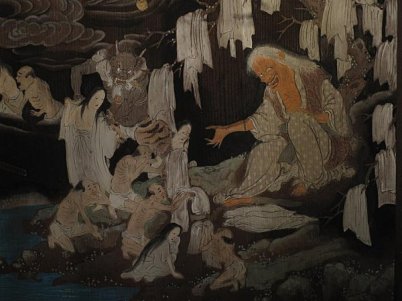
There are some lost innocent children souls that haven’t gain enough experience to cross the river. Datsue-ba will meet these souls before they are able to cross the river. She will take of their clothes and lie them to build a pile of pebbles until they reach the heaven. Then, she and underworld demons will bully them by knocking it down before it get higher and higher. Fortunately, there is a Bodhisattva named Jizo. He will protect these children souls from building up the pile by hiding them in his robe. It is believed that the pile that the children build is a symbolic stupa that helps them to remember their parents.
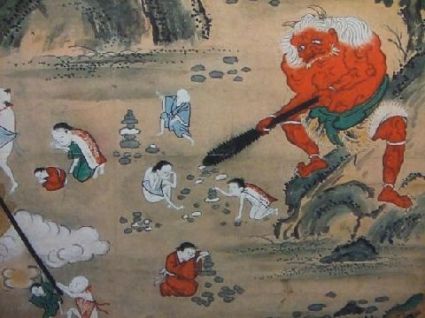
Datsue-ba, as how she was depicted, looks evil and frightening in nature. In some records, she has red skin like most demons in folklores would have. In my point of view, I believed that Datsue-ba is portrayed this way to make people feel fear against her, so that they would not commit sin. Her red skin may represent about powerful, cruel, and dangerous. In my perspective, the reason Datsue-ba has an appearance of an old woman is to show that she has a lot of experiences in life; the things she has gone through is not something good too, so she looks ugly instead of being beautiful. Moreover, Datsue-ba, though the fact the she is a woman, wore loose Japanese clothes which most statues and pictures usually showed her breasts. In my perspective, this is because monsters are not supposed to look nice. Additionally, many other Japanese monsters created in the old period also wear clothes loosely, so I think this is the old traditional way to show that Datsue-ba is a demon. In the other hand, this could represent her role in hell of how she ripped off a sinned person’s clothes by not wearing much concealing clothes herself.

How Datsue-ba is viewed in the past and now has a lot of differences. Even though Datsue-ba is still worshipped at some parts of Japan (Schumacher, n.d.), she is more well-known to teenagers nowadays as a character in games involving demons. In a popular game called “Shin MegamiTensei”, the player can obtain the demon Datsue-ba and use her to fight in the player’s party (Datsue-Ba, n.d.). Still, she is depicted as a scary old woman and her origin remains unchanged. There is also a popular Japanese cartoon television comedy, named “Hoozuki no Reitetsu”, show about demons that work in hell. In the cartoon, Daetsu-ba can also be seen. Although the script was made for her to play funny roles, but her appearance still resembles the original Daetsu-ba, such as loose clothes that almost shows her breast and sharp teeth. Furthermore, she also talks about her duties of stripping other people’s clothes too.
Therefore, in my opinion, Datsue-ba is a scary old woman in hell which I’m sure no one will wish to encounter her. However, though this old hag ripped off people’s clothes or trick lost children souls (Heritage of Japan, 2012), she is just doing what she’s supposed to do. This is her duty and the people she ripped their clothes off are just paying for their sins. Datsue-ba might not be the scariest demon you will ever heard of, but maybe she might help you think over whenever you are trying to commit a sin.
References
Datsue-Ba. (n.d.). Retrieved from http://megamitensei.wikia.com/wiki/Datsue-Ba
Dentsdelion Antiques Tokyo Newsletter. (2012). Jizô (地蔵) bodhisattva. Retrieved from http://www.dentsdelion.com/NEWSLETTER/08_2012_05-06.pdf
Heritage of Japan. (2012, September 1). Japanese yama-uba (a.k.a. jigoku no baba; datsueba): The universality of the Baba yaga mountain crone. Retrieved from http://heritageofjapan.wordpress.com/2012/09/01/japanese-yama-uba-a-k-a-jigoku-no-baba-datsueba-the-universality-of-the-baba-yaga-mountain-crone/
Kunimitsu, K. (1994) Datsueba, IMJS Reports 5(1) April 1994
Meyer, M. (2014, February 23). Meido: The Japanese underworld. Retrieved from http://matthewmeyer.net/blog/2014/02/23/meido-the-japanese-underworld/
Schumacher, M. (n.d.) Riverbed of the Netherworld Japanese limbo for children. Retrieved from http://www.onmarkproductions.com/html/sai-no-kawara.html
Collage Sketches
